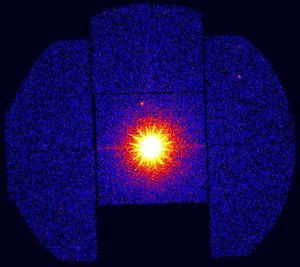Accept all cookies Accept only essential cookies See our Cookie Notice

About ESA
The European Space Agency (ESA) is Europe’s gateway to space. Its mission is to shape the development of Europe’s space capability and ensure that investment in space continues to deliver benefits to the citizens of Europe and the world.
Highlights
ESA - United space in Europe
This is ESA ESA facts Member States & Cooperating States Funding Director General Top management For Member State Delegations European vision European Space Policy ESA & EU Space Councils Responsibility & Sustainability Annual Report Calendar of meetings Corporate newsEstablishments & sites
ESA Headquarters ESA ESTEC ESA ESOC ESA ESRIN ESA EAC ESA ESAC Europe's Spaceport ESA ESEC ESA ECSAT Brussels Office Washington OfficeWorking with ESA
Business with ESA ESA Commercialisation Gateway Law at ESA Careers Cyber resilience at ESA IT at ESA Newsroom Partnerships Merchandising Licence Education Open Space Innovation Platform Integrity and Reporting Administrative Tribunal Health and SafetyMore about ESA
History ESA Historical Archives Exhibitions Publications Art & Culture ESA Merchandise Kids Diversity ESA Brand Centre ESA ChampionsLatest
Space in Member States
Find out more about space activities in our 23 Member States, and understand how ESA works together with their national agencies, institutions and organisations.
Science & Exploration
Exploring our Solar System and unlocking the secrets of the Universe
Go to topicAstronauts
Missions
Juice Euclid Webb Solar Orbiter BepiColombo Gaia ExoMars Cheops Exoplanet missions More missionsActivities
International Space Station Orion service module Gateway Concordia Caves & Pangaea BenefitsLatest
Space Safety
Protecting life and infrastructure on Earth and in orbit
Go to topicAsteroids
Asteroids and Planetary Defence Asteroid danger explained Flyeye telescope: asteroid detection Hera mission: asteroid deflection Near-Earth Object Coordination CentreSpace junk
About space debris Space debris by the numbers Space Environment Report In space refuelling, refurbishing and removingSafety from space
Clean Space ecodesign Zero Debris Technologies Space for Earth Supporting Sustainable DevelopmentApplications
Using space to benefit citizens and meet future challenges on Earth
Go to topicObserving the Earth
Observing the Earth Future EO Copernicus Meteorology Space for our climate Satellite missionsCommercialisation
ESA Commercialisation Gateway Open Space Innovation Platform Business Incubation ESA Space SolutionsLatest
Enabling & Support
Making space accessible and developing the technologies for the future
Go to topicBuilding missions
Space Engineering and Technology Test centre Laboratories Concurrent Design Facility Preparing for the future Shaping the Future Discovery and Preparation Advanced Concepts TeamSpace transportation
Space Transportation Ariane Vega Space Rider Future space transportation Boost! Europe's Spaceport Launches from Europe's Spaceport from 2012Latest
Stories from XMM-English
ESA's X-ray Multi Mirror Observatory (XMM), now renamed XMM-Newton, was launched by Ariane 5 on December 9th 1999. The most sensitive X-ray satellite yet, it carries three advanced x-ray telescopes that look at millions of X-ray sources in the Universe. Each telescope bears 58 high-precision mirrors which reflect X-rays onto sensors giving XMM capacity for long, uninterrupted observations at very high levels of sensitivity. This index provides background information on XMM technology, the construction of XMM, and its role within space science. It contains some highly-animated graphics, live pre-launch footage, and instructive commentary in English, in a series of 9 self-standing chapters arranged as follows: AN OBSERVATORY IN SPACE: why we need XMM, what it will do, how it will work. [This chapter also found in XMM Campaign Video] NEWS OF EXPLODED STARS - how a supernova is formed, and how XMM will study them. [This chapter also found in XMM Campaign Video] WAYS OF LOOKING - a description of XMM' technology, and its process of observation. GIANT BLACK HOLES - a description of black holes and XMM's capacity to look at the X-rays they emit. GOLDEN EYES - the construction of XMM. VAMPIRE STARS - a description of vampire stars. X RAY VISION - a description of XMM's instruments, and what they can do, including the Reflection Grating Spectrometer(RGS) and the European Photon Imaging Camera(EPIC). THE MAKING OF XMM - includes XMM construction footage; X-ray testing and calibration; spacecraft construction; vibration testing at ESTEC; transportation of XMM to Kourou via barge, lorry and the MM Toucan. THE BIG PICTURE - an overview of possibilities for space observation and research using XMM.
-
CREDIT
ESA -
LICENCE
ESA Standard Licence
-
Documentary
-
-
-
-
-
-

X-ray view of the Galactic Centre

X-ray and optical view of the Perseus galaxy cluster

X-ray and optical view of the Coma galaxy cluster

XMM-Newton’s image of X-ray nova IGR J17497-2821















 Germany
Germany
 Austria
Austria
 Belgium
Belgium
 Denmark
Denmark
 Spain
Spain
 Estonia
Estonia
 Finland
Finland
 France
France
 Greece
Greece
 Hungary
Hungary
 Ireland
Ireland
 Italy
Italy
 Luxembourg
Luxembourg
 Norway
Norway
 The Netherlands
The Netherlands
 Poland
Poland
 Portugal
Portugal
 Czechia
Czechia
 Romania
Romania
 United Kingdom
United Kingdom
 Slovenia
Slovenia
 Sweden
Sweden
 Switzerland
Switzerland


























